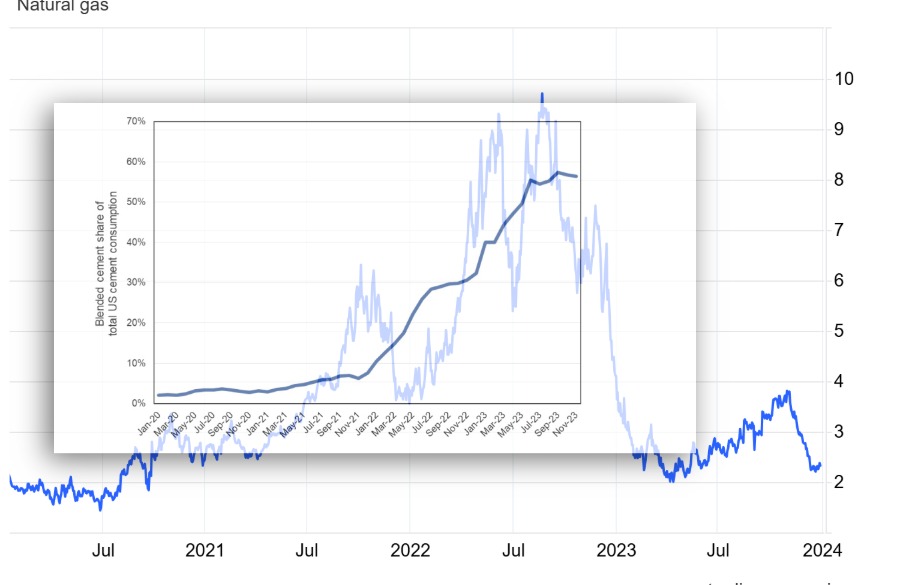The Real Reason Type IL Took Over: An Energy Crisis, Not a Climate Plan

Follow the Line. Follow the Money.
If you’ve been following the Type IL situation the last few years, you’ve heard every excuse under the sun about why Portland limestone cement suddenly became the “future” of American concrete. We’ve been told it’s about decarbonization, sustainability, Buy Clean, global alignment, protecting the planet, and all the other buzzwords you see in corporate annual reports when a company is trying to score tax incentives.
But here’s the thing most people never bothered to check: the timing.
And when you line up the actual charts — not the marketing pieces — the story changes fast.
Blended Cement Share of Total US Cement Consumption (Jan 2020 – Jul 2023) - State of the Art Report 2024
Look at that curve. From early 2020 all the way until spring 2021, blended cements barely moved above 5%. Nobody cared about Type IL. Nobody was switching. It was a rounding error in the market.
Then something happened.
Now look at the natural gas chart over the exact same period.
Natural Gas Prices (Jan 2020 – Dec 2023) - Trading Economics
Suddenly the picture gets real clear.
Natural gas starts rising in spring 2021.
Blended cement starts rising in spring 2021.
Natural gas explodes through 2022.
Blended cement explodes through 2022.
Natural gas collapses in early 2023.
Blended cement adoption immediately slows down and flattens.
These two lines behave like they’re holding hands.
What this means is simple: the cement industry didn’t sprint toward Type IL because it suddenly found religion on “carbon reduction.” It sprinted because its energy bill went through the roof. Cement plants run on heat. Lots of it. And clinker — the heart of Portland cement — is the most energy-heavy material in the entire construction industry.
So when the cost of energy spikes, the cost of clinker spikes. And when the cost of clinker spikes, the easiest way to protect profits is to reduce the amount of clinker you make.
That’s Type IL.
Swap in 10–12% cheap limestone — or more, depending on the plant — and call it a “low-carbon solution.” The tax-credit world cheers. The cement industry saves on fuel. The associations publish roadmaps. Everybody wins, except the part of the industry that actually places concrete and deals with the real-world consequences.
This is why I’ve said before: I don’t think the decarbonization push survives meaningful changes in EPA policy or a weakening economy. It’s not built on durability or performance. It’s built on cost pressure and corporate incentives. And the moment those incentives shift, the enthusiasm evaporates.
Look back at the Type IL curve. The industry flatlined the second natural gas got cheap again.
If this was truly about saving the planet, the line would keep rising regardless of energy price. But the line tells the truth: this was always a cost-saving play first and a climate-messaging play second.
And now we’re watching INDOT get framed as the “problem child” simply for pointing out that maybe — just maybe — rapid material changes inside America’s most dogmatically slow-moving industry should be reviewed before everyone pretends it’s business as usual.
They didn’t ban Type IL. They simply capped the limestone portion at 10% because they were seeing issues in the field and didn’t want variation swinging from 7.6% all the way to 12.4% while everyone else swore this stuff was a one-to-one replacement. They’re doing what DOTs are supposed to do: protect their taxpayers and their infrastructure.
The truth is the truth: the cement industry made a massive chemistry shift under financial pressure, wrapped it in green messaging, and pushed it into the market faster than anyone on the construction side could reasonably react.
The charts tell the real story. You don’t need a task force or a white paper. Just look at the timing.
This wasn’t climate policy.
This wasn’t sustainability.
This wasn’t saving the planet.
This was an energy crisis, and Type IL was the release valve.
Let’s keep it concrete.














